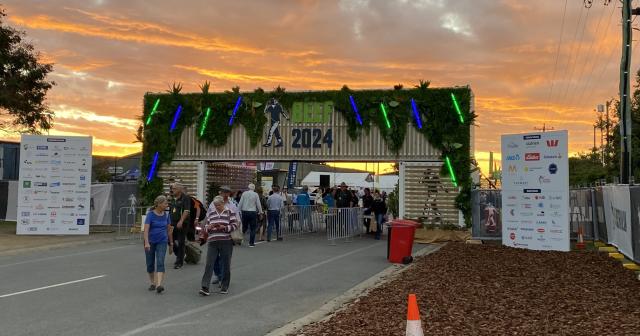During a recent trip to Australia, B+LNZ representatives attended Beef Week in Queensland to reconnect with the Australian, US, and Canadian beef industries and identify avenues for future collaboration. Read the full blog below.

Beef Australia is held every three years and with the last one being impacted by COVID-19, this was the largest ever, with record crowds of 119,324 people attending over the course of the week.
The event covers everything beef related – from cattle showing, beef restaurants, tech demonstrations, trade fairs, seminars on a wide range of topics and beef sales. There was a wide range of attendees, from school groups and education, and businesses that work closely with the beef industry such as banks, processors, and industry organisations.
From B+LNZ, Board Chair Kate Acland, chief executive Sam McIvor, Eastern North Island Director Patrick Crawshaw and Senior Trade Policy Advisor Nicholas Jolly) attended.
With the Canadian Cattle Association (CCA) and the USA National Cattlemen’s Beef Association (NCBA) also attending along with Australian and New Zealand beef industry groups, Beef Australia provided an opportunity for leaders from the four countries to meet in person and strengthen relationships.
Previously, cooperation had been focused on trade and support for increased liberalisation through reduced tariffs and science-based import requirements. While trade continues as a key focus, as the four countries make up 41 percent of the global beef trade, there is recognition that we also need to work closely on issues such as sustainability, food safety, and nutrition.
The general sentiment within the Australian beef industry was positive, with sustainability being seen as an opportunity. The Australian Beef Sustainability Framework launched its 2024 Annual Update which sets out how the Australian beef industry is meeting its goals across a range of areas, such as animal welfare, environmental stewardship, economic resilience and people and the community.
This is supported by the Australian Government, who see the report as demonstrating that the beef industry is moving in the right direction and does not require regulation. In Australia, there are further incentives provided by banks, processors, and retailers who are encouraging farmers to adopt more sustainable practices.
While New Zealand farmers may be further along this pathway of sustainability, using metrics such as the number of farmers who know their number and have a plan to manage emissions, the Australians are catching up fast.
Carbon sequestration was a hot topic, with many businesses offering ways to measure, validate, and sell soil and vegetation carbon credits. This was surrounded by a lot of positivity, but there was little discussion of the liability associated with these credits should there be a fire or an extended dry period.
The final seminar that we attended, titled “Navigating Greenwashing and what we must do now” covered that to verify soil carbon effectively took 5-10 years and cost more than the farmer would receive back from selling the credits. He believed that a more appropriate strategy was to aim for climate neutrality, which recognised the short-lived nature of methane and set appropriate targets, rather than using GWP100 and attempting to offset emissions through sequestration. This aligns with B+L NZ’s views of how the red meat sector should approach emissions reductions.
While there are a range of views within Australia on methane metrics and appropriate targets, a separate seminar, held by the Department of Agriculture, Fisheries and Forestry (MPI’s Australian equivalent) recognised that methane needed a target that reflected its short-lived nature, pointing out that currently only New Zealand currently had a split gas target. This seemed to indicate that the Australian government was open to a split gas target although they have the added complexity of a fossil fuel sector that also emits methane.
B+L NZ has good conversations with Australian, Canadian, and US counterparts on carbon and climate neutrality and what appropriate targets are for the industry. It remains B+LNZ’s position that we need to focus on no additional warming, with climate neutrality therefore the most suitable for ruminant agriculture/sheep and beef farming as it recognises the short-lived nature of methane. Of these countries, the United States beef industry has already set a target of being climate neutral by 2040.
The trip was successful, with improved relationships and agreement between Cattle Australia, NCBA, and the Canadian Cattle Association to work more closely together. Understanding what the Australian cattle industry is doing well and how they are approaching sustainability was useful, while also recognising that there are differences in opinion within the Australian industry on challenging issues such as methane which provide opportunities for future collaboration with New Zealand.